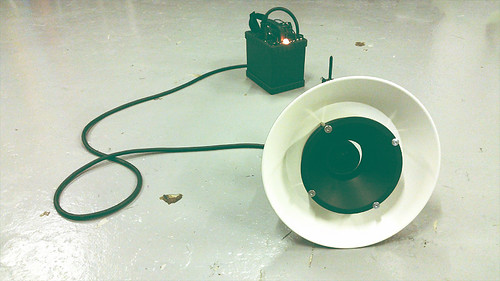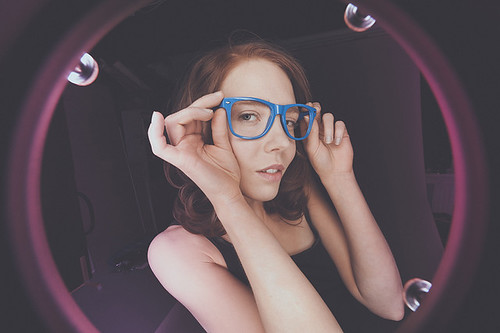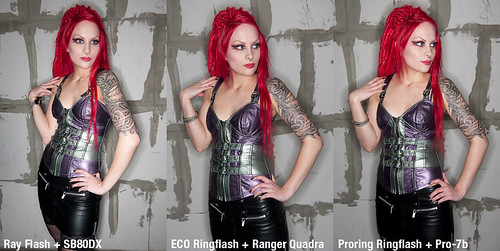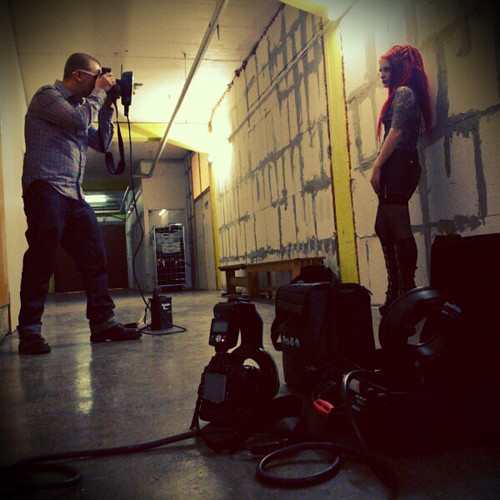
This blog entry is about ringflashes. Some observations after using them (especially one from Profoto) few times and quick comparison between three different units. Image above: Profoto ringflash + widesoft reflector using Pro-7b as power source.
I am not a big fan of monotonous and harsh ring flash as main light look, but it works pretty well for fill light. Examples of that use will be covered in separate post. Ring can be also used to create flat lighting to push the images even further in post processing. Like photographer Kristofer Lönnå is doing.

Ringflash is challenging to transport and store because of its size & form. When you disassemble the parts to attach it to camera, it fits nicely to the most bags or cases, like HRPC case in the image above. Assembling the ring and attaching it to camera is relatively quick operation, as it only takes some minutes. Attaching widesoft reflector (aka beauty dish for ring) to soften up the light takes another few minutes.
First impressions after using the Proring ringflash few times:
- Proring gives lots of oomph even with lowest power setting (depending of course the generator's power settings). Proring + widesoft used with Pro-7b set to -5 EV for close-ups photos got ok exposures with ISO 100 & F13. On the positive side of high light output, it means that you can use the ring with really low power and get fast recycle times.
- There is no fan-cooling in Proring, so it is adviced not to shoot over 9600 Ws per minute, which translates to eight 1200 Ws pops per minute. This can be now important factor if you need really powerful ringflash for example to be used with medium format camera. Proring's big brother Proring2 is fan-cooled and capable of as many 2400 Ws flashes per minute as the generator can produce.
- You don't need to go to gym anymore as the ring + widesoft is yet another +2 kilos to hold in addition of camera's weight.
- With added weight comes robust & solid build. Proring's metallic build feels better than with plastic feel of some other ringflash products.
- Using shutter button in battery grip can be difficult while the ringflash is attached to camera
- Widesoft reflector makes the light spread bigger and soften shadows. It is also rather big modifier so you can hide behind it. This can be problem as you migh lose the contact to subject. I occasionally felt like talking wok pan while using it at studio.
- You have to remove Proring from camera when attaching or removing widesoft reflector. I wish this would have been designed some smarter way as it is lot of effort to do during shoot.
- Superwideangle + ringflash = kookiness (image below)

Ringflash + widesoft reflector with 15mm lens. You can see the widesoft reflector knobs in photo. Note that inner rim of the widesoft reflector was toned in the post. It is normally not pink. Model: Laura

Elevator portrait taken using Proring ringflash on camera. Colors adjusted and vignetting added. Model: Minna
Ringflash comparison

Then during the second studio session I quickly tested three different ringflashes. Quick examples above that illustrates the light characteristics from three different ringflashes. All photos taken f5.6, 1/200 sec, ISO 200 with Nikkor 24-70mm/f2.8 lens. Distance to subject was about one meter and distance between subject and background wall around 50 cm. White balance was corrected to be same in all photos. Ray Flash & SB-80DX was giving colder light than the other two bigger units. How much this was caused by the Ray Flash modifier, instead of the speedlight, wasn't tested.
Surprising finding was that 150€ Ray Flash gives about same look as much more expensive ECO or Proring ringflashes. Light is however not that even with Ray Flash as can be seen on Minna's arms which are brighter than in other photos. SB-80DX was running 1/2 power for f5.6. I think Ranger Quadra was set to quite low power and Pro-7B was running -5 or -6 EV power. If you need to work from longer distance to subject, Ray Flash's power efficiency is maybe not going to be enough, but for close up work especially when pumping ISO, it should give enough light for portraits.

Ringflash test setup. ECO currently in use by "the other other Marko". Ray Flash & Proring on the ground, waiting to be tested.

Found out from the archives that I have used the same infamous wall as background before. This was taken during 2009. Model: Sandy Jungle, MUA: Linda H. Setup: SB-800 with Ray Flash ring flash adapter.
No comments:
Post a Comment